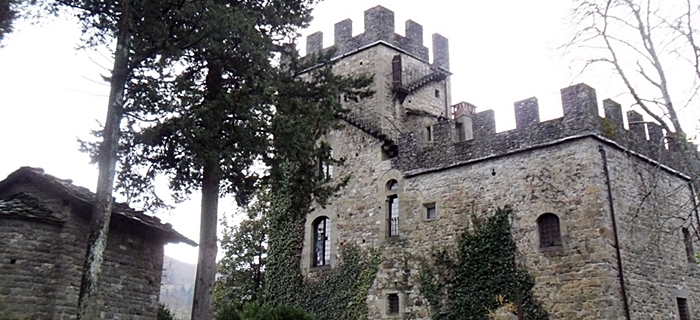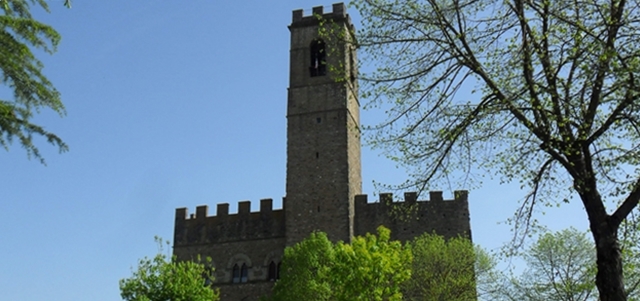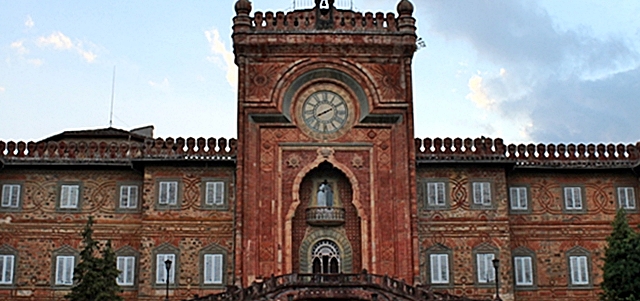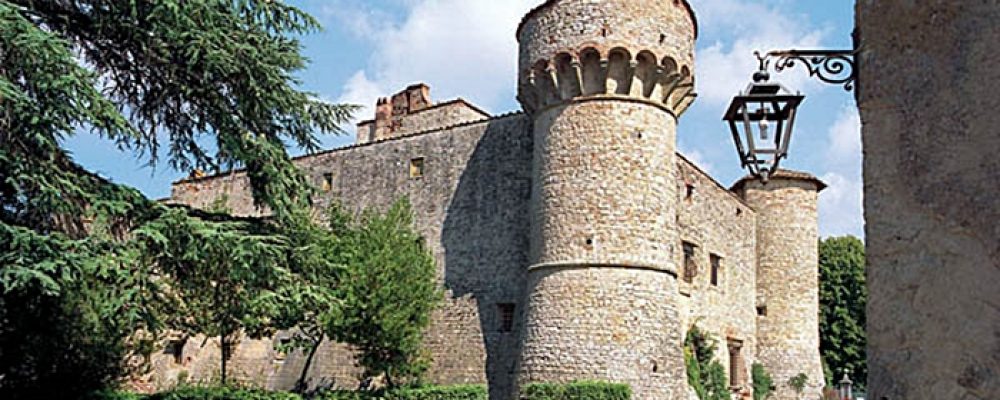For lovers of history and architecture or simply for the curious who dream of a journey through time, Tuscany is full of countless castles, each with a different history or legend, a location that can revive the atmosphere typical of the courts . The peculiarity is certainly given by the fact that the landscape and the nature that surround them – always different according to the area – together with the castles itself – depending on the historical period, any foreign dominations and cultural and artistic ferment of the time take on specific characteristics – create a very fascinating mix that makes visiting castles even more a new and unique experience.
CASTLE OF BROLIO

Where: Gaiole in Chianti (SI)
Il The castle of Brolio, immersed in the Chianti area and precisely in the municipality of Gaiole in Chianti, appears at first sight as the typical medieval castle which, however, like the previous one, will not fail to reserve a surprise. Its history is full of vicissitudes closely linked to the continuous struggles between Florence and Siena: its position and its belonging to the Florentine territory made it the constant object of attacks by Siena and to nothing worth the continuous fortification works, three bastions and tower lookout. But after the definitive Florentine conquest of Siena, the turning point took place: from being a fortress it became an important agricultural and winery in the hands of the aristocratic Ricasoli family for centuries. And to its new functional appearance followed the aesthetic one: apart from some typically medieval elements, during the ‘800 – under the guidance of Bettino Ricasoli – it assumed more and more the appearance of an English manor, with neo-gothic and tudor elements. It worths absolutely a walk in the garden, which combines the Italian style with that of the nineteenth-century English park.
CASTLE OF GARGONZA

Where: Monte San Savino (AR)
Another interesting destination is the castle of Gargonza, a fortified village in Monte San Savino, in the province of Arezzo. Also in this case the tumultuous historical events have influenced its history: the conflicts between Siena and Florence, Guelphs and Ghibellines, inevitably involved it, causing its almost total destruction except for the crenellated tower. Although it has never been densely populated, the exodus of the rest of the population around the mid-twentieth century pushed the descendants of the noble Corsi family, owners from the eighteenth century, to renovate it and bring it back to the ancient prestige, making it an attractive farmhouse.
CASTLE OF VINCIGLIATA

Where: Fiesole (FI)
The castle of Vincigliata, near Fiesole, whose origins date back to 1031, experienced ups and downs due to its owners, noble Florentine families that followed one another over time without giving due importance to the structure that soon fell into disrepair. Its flourishing is due to an exceptional English figure, the very rich John Temple Leader who, in 1850, not only fell in love with the castle but the surrounding nature, engaged in an exceptional work of restructuring and reforestation that brought it back to that ancient splendor that had attracted many writers and artists in the past for its inspiring beauties. He then passed on to Lord Westbury. Do not miss the garden between bridges, streams, statues and aquatic plants, in typical romantic style.
CASTLE OF PORCIANO

Where: Pratovecchio e Stia (AR)
The castle of Porciano, near Stia in the province of Arezzo, was not immune from the local war riots and the decay that often occurred when the productive and commercial necessities pushed towards other more strategic locations, leaving these places in a state of neglect . Fortunately, as in previous cases, even in this there is a family that decides to take on the burden and the honor of renovating it and offering its beauties to the public: Flaminia Goretti de Flamini and George Specht. The work began in the 60s, they completed them after a little over a decade setting up a museum where you can admire objects and tools of the daily life of the time. The sources tell that this castle was well known and frequented by nobles and knights of the time and, not least, Dante Alighieri was imprisoned there following the battle of Campaldino.
CASTLE OF CASTIGLIONE DEL TERZIERE

Where: Bagnone (MS)
Built on a Byzantine site in the municipality of Bagnone, in the province of Massa-Carrara in Lunigiana area is a typical example of a medieval castle, it assumed the toponym of “Castiglione del Terziere” when it became part of the many possessions inherited by the Marquis Alberto Malaspina in 1275. Its prestige grew more when in the fifteenth century, with the occupation of Florence, the seat of its courthouse was installed there, making it a real Renaissance residence. However, it knew too a phase of decline that was cleverly interrupted by a great intellectual, physician and poet – Loris Jacopo Bononi – who in thirty years of restructuring created within it a library of great prestige, with unique documents and pieces, and a meta-museum that attracts scholars from all over the world, fascinated by being able to relive the fervor of humanist culture.
CASTLE OF POPPI

Where: Poppi (AR)
This castle in the Casentino, built between the twelfth and fourteenth century by the Guidi family is a splendid example of a medieval castle that can be seen from most of the valley of eastern Tuscany. Its elegant structure and its architectural elements suggest, even if there are no actual confirmations, that Lapo di Cambio first and Arnolfo di Cambio later took part in the design and construction of the castle that would seem to represent the prototype of “Palazzo Vecchio” in Florence.
Long list of prominent elements: from the noble coats of arms, to the frescoes by Taddeo Gaddi (Giotto’s pupil), the residential rooms of the Guidi Family, the party hall, the prison and the famous Rilliana library with 25,000 volumes of inestimable value. In this castle it is said that Dante spent time during his exile and composed the XXXIII canto of Hell. Worthy conclusion of the visit certainly that of the tower from which you can admire and dominate the entire valley.
CASTLE OF MALASPINA / FOSDINOVO

Where: Fosdinovo (MS)
The castle is located precisely in Fosdinovo, province of Massa Carrara, and is the largest of Lunigiana area. It takes its name from the Malaspina Family of the flowery Spino of which it was the residence between the fourteenth and eighteenth centuries. The members of the family worked hard to enlarge it, embellish it and give it the appearance of a noble residence. Among the curiosities of the castle: Dante’s room, where the poet would have stayed during a part of his exile, the torture chamber and the “mantrap room” (in reality there were more traps scattered throughout the castle). In particular the legend tells that the marquise Cristina Pallavicini, famous for her wickedness and lust, killed her lovers by making them fall from the trapdoor at the end of the bed. But a even more interesting legend is that of Bianca Maria Aloisia, Giacomo Malaspina’s daughter: in love love with a groom, she was tortured by the family with the hope of bending her will, but this did not happen and she was walled alive in a cell, together with a dog, a symbol of loyalty, and a boar, the emblem of rebellion. Many swear to have seen the ghost of this girl with long hair walking in the castle.
CASTLE OF SAMMEZZANO

Where: Reggello (FI)
The castle of Sammezzano, for example, is located in the municipality of Reggello, in the province of Florence and – specifically – in a place called Leccio. This castle, confirming what was said before, will amaze visitor’s expectation that as soon as he crosses its threshold will be catapulted into a very Arabic style setting, made of domes of intertwined arches, bright colors, ceramic mosaics typical of that technically orientalist style called “Moorish” which had established itself as an example of Islamic art between the late eleventh and fourteenth centuries in that basin of the Western Mediterranean that saw as active protagonists Spain and the Maghreb countries. How comes this transposition of styles in Tuscany? Although it is of ancient origins (probably of the Roman era), it was initially a farm and then, thanks to the skilful renovation works by the Ximenes d’Aragona family and above all through the figure of Ferdinando, patron and admirer of new oriental artistic influences, it turned into a castle. Do not underestimate the immense park that surrounds it, with an incredible botanical variety.
CASTLE OF MONTERIGGIONI

Where: Monteriggioni (SI)
The castle of Monteriggioni is about 10 minutes drive from Siena. Built around 1200 it is an imposing structure that seems almost to resemble a crown because of the fourteen towers that surround the walls, remembered also by Dante in the Divine Comedy. The aspect remained almost the same except for some changes, such as the height of the towers in the sixteenth century (were made lower) and land that was accumulated at the base of the walls to adapt to new firearms and new types of combat . Do not miss the walk on the walls from which you can admire the Sienese hills and the museum of weapons and armor where you can find accurate medieval and Renaissance reproductions and reproduction of the siege techniques of this fortification as well.
CASTLE OF THE EMPERATOR OF PRATO

Where: Prato (PO)
The castle of Prato stands out for its being a magnificent example of anomalous Federician architecture in central and northern Italy. Its construction, begun in 1248, took place by the architect Riccardo da Lentini – who came especially from Puglia – to which Frederick II of Swabia had commissioned this work to act together with others as an element of military control within a wider project ranging to monitor the main communication routes of Italy from the South of to Germany. There are obvious references to the Federician building par excellence, namely Castel Del Monte. After alternating events that were bringing it to ruin and having been used mostly as a prison, the castle has been carefully restored and made accessible to visitors who can admire the city of Prato and the surrounding area.
TREBBIO CASTLE

Where: Pontassieve (FI)
The Trebbio Castle is located in the Municipality of Pontassieve, in the province of Florence. Property of the Guidi family, then Pazzi family, then confiscated by Lorenzo the Magnificent and then again of the Pazzi until the eighteenth century, it became a private property in 1968. Multiple are the elements for which it stands out: here you can attend the various activities of the farmstay being actively involved in wine and oil tastings, cooking classes, learning more about the precious saffron that is cultivated here and produced at the highest level.
WHERE TO EAT AND SLEEP
If after visiting the castles you are not yet ready to leave that atmosphere and want to experience it fully as a guest, there are many castles converted to accommodation facilities.
Among these we point out the Castle of Valenzano and the Trebbio castle.
The Castle of Valenzano, just a few minutes from Arezzo in the municipality of Subbiano, offers the possibility of accommodation, lunches, organization of conferences and cultural events. First entrusted to the Monks of Camaldoli and then from 1386 under the control of Florence, it was renovated starting from 1870: the current version provides some medieval remains inside, suggestive cellars in addition to the flagship of the old mill with original stone millstones. The restaurant offers reinterpretations of traditional cuisine with a menu always new according to seasonal products.



